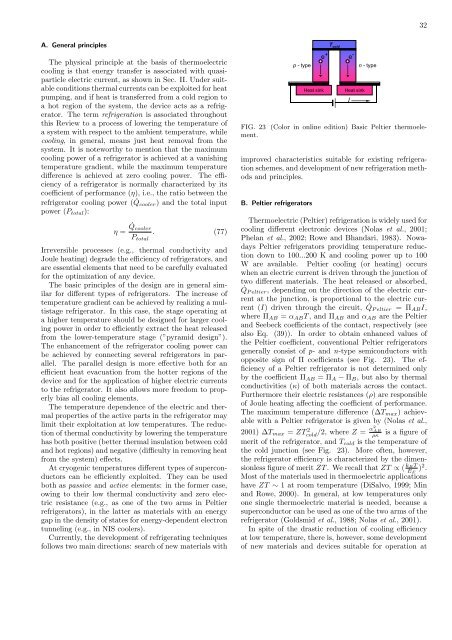Thermal properties in mesoscopics: physics and ... - ResearchGate
Thermal properties in mesoscopics: physics and ... - ResearchGate
Thermal properties in mesoscopics: physics and ... - ResearchGate
You also want an ePaper? Increase the reach of your titles
YUMPU automatically turns print PDFs into web optimized ePapers that Google loves.
A. General pr<strong>in</strong>ciples<br />
The physical pr<strong>in</strong>ciple at the basis of thermoelectric<br />
cool<strong>in</strong>g is that energy transfer is associated with quasiparticle<br />
electric current, as shown <strong>in</strong> Sec. II. Under suitable<br />
conditions thermal currents can be exploited for heat<br />
pump<strong>in</strong>g, <strong>and</strong> if heat is transferred from a cold region to<br />
a hot region of the system, the device acts as a refrigerator.<br />
The term refrigeration is associated throughout<br />
this Review to a process of lower<strong>in</strong>g the temperature of<br />
a system with respect to the ambient temperature, while<br />
cool<strong>in</strong>g, <strong>in</strong> general, means just heat removal from the<br />
system. It is noteworthy to mention that the maximum<br />
cool<strong>in</strong>g power of a refrigerator is achieved at a vanish<strong>in</strong>g<br />
temperature gradient, while the maximum temperature<br />
difference is achieved at zero cool<strong>in</strong>g power. The efficiency<br />
of a refrigerator is normally characterized by its<br />
coefficient of performance (η), i.e., the ratio between the<br />
refrigerator cool<strong>in</strong>g power ( ˙ Qcooler) <strong>and</strong> the total <strong>in</strong>put<br />
power (Ptotal):<br />
η = ˙ Qcooler<br />
. (77)<br />
Ptotal<br />
Irreversible processes (e.g., thermal conductivity <strong>and</strong><br />
Joule heat<strong>in</strong>g) degrade the efficiency of refrigerators, <strong>and</strong><br />
are essential elements that need to be carefully evaluated<br />
for the optimization of any device.<br />
The basic pr<strong>in</strong>ciples of the design are <strong>in</strong> general similar<br />
for different types of refrigerators. The <strong>in</strong>crease of<br />
temperature gradient can be achieved by realiz<strong>in</strong>g a multistage<br />
refrigerator. In this case, the stage operat<strong>in</strong>g at<br />
a higher temperature should be designed for larger cool<strong>in</strong>g<br />
power <strong>in</strong> order to efficiently extract the heat released<br />
from the lower-temperature stage (”pyramid design”).<br />
The enhancement of the refrigerator cool<strong>in</strong>g power can<br />
be achieved by connect<strong>in</strong>g several refrigerators <strong>in</strong> parallel.<br />
The parallel design is more effective both for an<br />
efficient heat evacuation from the hotter regions of the<br />
device <strong>and</strong> for the application of higher electric currents<br />
to the refrigerator. It also allows more freedom to properly<br />
bias all cool<strong>in</strong>g elements.<br />
The temperature dependence of the electric <strong>and</strong> thermal<br />
<strong>properties</strong> of the active parts <strong>in</strong> the refrigerator may<br />
limit their exploitation at low temperatures. The reduction<br />
of thermal conductivity by lower<strong>in</strong>g the temperature<br />
has both positive (better thermal <strong>in</strong>sulation between cold<br />
<strong>and</strong> hot regions) <strong>and</strong> negative (difficulty <strong>in</strong> remov<strong>in</strong>g heat<br />
from the system) effects.<br />
At cryogenic temperatures different types of superconductors<br />
can be efficiently exploited. They can be used<br />
both as passive <strong>and</strong> active elements: <strong>in</strong> the former case,<br />
ow<strong>in</strong>g to their low thermal conductivity <strong>and</strong> zero electric<br />
resistance (e.g., as one of the two arms <strong>in</strong> Peltier<br />
refrigerators), <strong>in</strong> the latter as materials with an energy<br />
gap <strong>in</strong> the density of states for energy-dependent electron<br />
tunnel<strong>in</strong>g (e.g., <strong>in</strong> NIS coolers).<br />
Currently, the development of refrigerat<strong>in</strong>g techniques<br />
follows two ma<strong>in</strong> directions: search of new materials with<br />
p - type<br />
e +<br />
T cold<br />
e -<br />
Heat s<strong>in</strong>k Heat s<strong>in</strong>k<br />
I<br />
n - type<br />
FIG. 23 (Color <strong>in</strong> onl<strong>in</strong>e edition) Basic Peltier thermoelement.<br />
32<br />
improved characteristics suitable for exist<strong>in</strong>g refrigeration<br />
schemes, <strong>and</strong> development of new refrigeration methods<br />
<strong>and</strong> pr<strong>in</strong>ciples.<br />
B. Peltier refrigerators<br />
Thermoelectric (Peltier) refrigeration is widely used for<br />
cool<strong>in</strong>g different electronic devices (Nolas et al., 2001;<br />
Phelan et al., 2002; Rowe <strong>and</strong> Bh<strong>and</strong>ari, 1983). Nowadays<br />
Peltier refrigerators provid<strong>in</strong>g temperature reduction<br />
down to 100...200 K <strong>and</strong> cool<strong>in</strong>g power up to 100<br />
W are available. Peltier cool<strong>in</strong>g (or heat<strong>in</strong>g) occurs<br />
when an electric current is driven through the junction of<br />
two different materials. The heat released or absorbed,<br />
˙QP eltier, depend<strong>in</strong>g on the direction of the electric current<br />
at the junction, is proportional to the electric current<br />
(I) driven through the circuit, ˙ QP eltier = ΠABI,<br />
where ΠAB = αABT , <strong>and</strong> ΠAB <strong>and</strong> αAB are the Peltier<br />
<strong>and</strong> Seebeck coefficients of the contact, respectively (see<br />
also Eq. (39)). In order to obta<strong>in</strong> enhanced values of<br />
the Peltier coefficient, conventional Peltier refrigerators<br />
generally consist of p- <strong>and</strong> n-type semiconductors with<br />
opposite sign of Π coefficients (see Fig. 23). The efficiency<br />
of a Peltier refrigerator is not determ<strong>in</strong>ed only<br />
by the coefficient ΠAB = ΠA − ΠB, but also by thermal<br />
conductivities (κ) of both materials across the contact.<br />
Furthermore their electric resistances (ρ) are responsible<br />
of Joule heat<strong>in</strong>g affect<strong>in</strong>g the coefficient of performance.<br />
The maximum temperature difference (∆Tmax) achievable<br />
with a Peltier refrigerator is given by (Nolas et al.,<br />
2001) ∆Tmax = ZT 2 α2AB<br />
cold /2, where Z = ρκ is a figure of<br />
merit of the refrigerator, <strong>and</strong> Tcold is the temperature of<br />
the cold junction (see Fig. 23). More often, however,<br />
the refrigerator efficiency is characterized by the dimensionless<br />
figure of merit ZT . We recall that ZT ∝ ( kBT<br />
EF )2 .<br />
Most of the materials used <strong>in</strong> thermoelectric applications<br />
have ZT ∼ 1 at room temperature (DiSalvo, 1999; M<strong>in</strong><br />
<strong>and</strong> Rowe, 2000). In general, at low temperatures only<br />
one s<strong>in</strong>gle thermoelectric material is needed, because a<br />
superconductor can be used as one of the two arms of the<br />
refrigerator (Goldsmid et al., 1988; Nolas et al., 2001).<br />
In spite of the drastic reduction of cool<strong>in</strong>g efficiency<br />
at low temperature, there is, however, some development<br />
of new materials <strong>and</strong> devices suitable for operation at
















